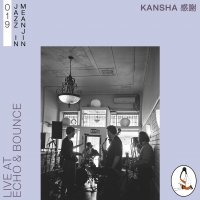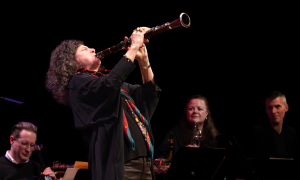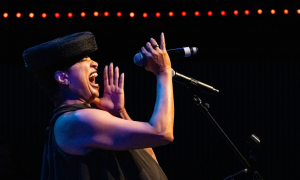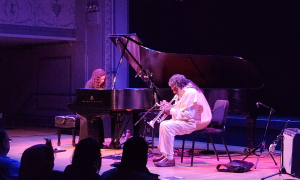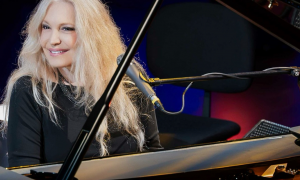Home » Jazz Articles » Live Review » Festival International de Jazz de Montreal 2008: Days 6-8
Festival International de Jazz de Montreal 2008: Days 6-8
McCoy Tyner Trio with Ravi Coltrane/Bran Van 3000 Catherine Russell/Steely Dan Steven Bernstein's Millennial Territory Orchestra/McCoy Tyner Big Band Festival International de Jazz de Montréal Montréal, Quebec, Canada July 1-3, 2008
Now nearing its thirty-year anniversary, the Festival International de Jazz de Montréal continues to create a universe unto itself. With six square city blocks closed in the city's downtown core, it's an eleven-day party that's marked by high spirits and complete safety—an unprecedented combination in a city this size.
The festival had to recover from the loss of Le Spectrum this year—a legacy venue that's been a part of the festival since inception. But with a new center planned near the site that will ultimately house the festival's offices and include new performance venues, while there was some adapting to do for the 2008 edition, it's now a certainty that things will not only recover, but will actually improve.
The festival is divided into two halves, with the middle day traditionally quiet on the ticketed show front. This year, however, not only was there one of the mammoth free outdoor spectaculars that the festival programs on the first, middle and final evenings, but there were some high profile indoor ticketed shows as well, including the first of two nights by Steely Dan, and the first of three nights by piano legend McCoy Tyner, one of three luminous guests comprising this year's By Invitation series (the other two being pianists Hank Jones and Dave Brubeck). The series allows its artists to bring a number of different contexts to the festival, and Tyner's ran the gamut from his working trio, augmented by saxophonist Ravi Coltrane, to a solo performance and his closing night with a big band, featuring trumpeter Christian Scott, who leads his own show later in the week.
Chapter Index
- July 1: McCoy Tyner Trio with Ravi Coltrane
- July 1: Bran Van 3000
- July 2: Catherine Russell
- July 2: Steely Dan
- July 3: Steven Bernstein's Millennial Territory Orchestra
- July 3: McCoy Tyner Big Band with Christian Scott
July 1: McCoy Tyner Trio with Ravi Coltrane
In the pantheon of jazz pianists, there are only a few who are instantly recognizable by first name: Herbie (Hancock), Chick (Corea) and, more recently, Brad (Mehldau). But before any of these names became household names, at least in the jazz world, there was McCoy. First coming to public attention as a member of saxophone pioneer John Coltrane's classic quartet of the '60s, responsible for classic albums including the seminal A Love Supreme (Impulse!, 1964), Tyner's powerful attack and dense clusters were the perfect foil for Coltrane's own layered sheets of sound.
Since leaving Coltrane in the mid-'60s, Tyner has gone on to create a sizable and significant discography with its own share of classics, including Time for Tyner (Blue Note, 1968) and Expansions (Blue Note, 1968), the latter reissued as part of a larger box, Mosaic Select 25 (Mosaic, 2007). A lengthy stint with Milestone through the 1970s grew Tyner's discography even more significantly, placing him in a variety of contexts but with his bold modal innovation continuing to evolve and expand. There is only one McCoy.
Moving slowly but looking less gaunt than he did at his 2006 performance at the Ottawa International Jazz Festival, Tyner's performance at the Théâtre Masionneuve of Place Des Arts with his working trio featuring bassist Gerald Cannon and drummer Eric Kamau Gravatt was a short but very sweet performance that found the pianist less the long-distance runner he used to be, but a still powerful sprinter. Even if the solos were relatively brief, he was in fine form, sounding just as powerful in inspired bursts as he did over forty years ago with John Coltrane.
Opening the show with the trio, Tyner required no time to establish the voice that has influenced so many others. Dramatic flourishes were juxtaposed with aggressive block chords, as Tyner ripped into his first solo with surprising energy. Cannon, a no less powerful soloist, worked hand-in-glove with Gravatt. Gravatt, who came to attention as the second drummer to go through fusion group Weather Report's revolving door on I Sing the Body Electric (Columbia, 1972) and Sweetnighter (Columbia, 1973), is only recently back on the scene, after decades away from music as a correctional officer at a prison. Based on his effervescent style, which combined bold power with surprising elegance and a light touch on a ride cymbal (that was nearly vertical and raised far above the rest of the kit), it's as if he never went away.
Tyner then introduced Ravi Coltrane, saying "I've known him since he was child. His father was my teacher," and a lifetime bond that went beyond the music was clear throughout the hour-long set, with Tyner and Coltrane playing as much to and for each other as for the capacity crowd. While the tenor player demonstrated an ability to create waves of sound like his late father John, he also displayed a strong penchant for melody, weaving lines through the changes rather than creating expansive sheets of sound. Literally leaning into the notes, his was a warmer and, at times, more visceral tone. As his own albums, including Flux (Savoy Jazz, 2005) and, more recently, Seraphic Light (Telarc, 2008), with Saxophone Summit, prove, he's evolved his own voice and has stepped out from under the shadow of his father.
He may be slowing down, but Tyner knew an appreciative audience when he saw it, coming back for not one, but two encores. The first, a barnstorming trio tune that demonstrated the power of an audience to energize those onstage, was the highlight of the evening, with Cannon and Gravatt creating a relentless groove that bolstered Tyner's dynamic attack. The final song of the night was a more relaxed, mid- tempo swinger that, with Coltrane returning to the stage, was a perfect closer to a show that, while short in duration, will undoubtedly be remembered by those in attendance as one of the festival's high points.
July 1: Bran Van 3000
The festival's Grand Évenément was labeled "Le Spectaculaire Retour de Bran Van 3000 (or BV3K). BV3K was the late '90s brainchild of aspiring filmmaker Jamie "Bran Man" Di Salvio, who collected a group of close to twenty unknowns and released two albums—Glee (Capitol, 1999) and Discosis (Virgin, 2001)—that were well-received on the Canadian charts before disappearing from the scene. With a new album, Rose (Emstar, 2007), Di Salvio's strong mix of classic R&B material with trip hop, electro-ambience and near-heavy metal attitude was the perfect show for the festival.
This was music meant to be experienced on a grand scale, and the huge crowd that gathered on St. Catherine Street and beyond rivaled those of Pat Metheny's closing show in 2005 and Seun Kuti's in 2007. By the time the group hit the stage, it was clear that the crowd—somewhere around the 100,000 mark— was ready for an evening of powerful dance grooves, delivered with the festival's usual meticulous and imaginative attention to sound and light. Images swirled around the buildings surrounding the main Scène General Motors stage, and the stage was a curious mix of high tech and chandeliers that were scattered throughout.
By the time "Bran Man" took to the stage for the band's second song— featuring a core group of players that included two keyboardists, two percussionists (one doubling on trombone), powerhouse drummer Ian Frye, two guitarists and bassist Gary McKenzie, who took an early solo rivaling electric bass phenom Marcus Miller—the crowd was already dancing, pumping arms and screaming on demand. Ear-shatteringly loud and gut-wrenching with low-end rumbles, it was precisely what they had gathered for.
With what seemed like an endless array of vocalists coming and going onstage, and with "Bran Man" a constant throughout, the show culled familiar material but transformed it into spectacle with a stage so busy it was often difficult to track the sequence of events. Thankfully there were some solo spots, along with shifts in groove- -from the more pulsing trip-hop to a lighter (but no less powerful or loud) reggae.
Not in any way a jazz performance, but the Festival International de Jazz de Montréal has long since evolved from being a "purer" event to one that's all- encompassing. There's plenty for those who favor the mainstream, but for those whose tastes run farther afield, Montréal's festival manages to provide a musical cross-section to cover the demands of the most broad-minded music fan.
July 2: Catherine Russell
Steely Dan's Think Fast tour selling out two nights at Place des Arts' Salle 3000-seat Wilfrid-Pelletier theater, combined with the festival's broad international audience, makes getting the opening act slot a very high visibility gig. Singer Catherine Russell's thirty-minute set was high on quality and more than a little retro on material but, all-in-all, a fine, relaxed opener that set the mood for an audience clearly pumped to be there to see The Dan.
Russell's father was the late pianist/bandleader Luis Russell, a contemporary of jazz legend Louis Armstrong, and if there was any quarrel to be had with the singer's set, it was her persistent calling on her father's name. Luis Russell may well have been an important figure, especially in early 20th Century New Orleans where, along with others, he was a part of the emergence of jazz, but invoking his name on introductions to half of the set's tunes began to feel like name-dropping, as if to suggest being the daughter of a great musician would mean the progeny were inherently no less talented.
Fortunately, intros or not, she was a fine singer, exhibiting a strong voice and solid interpretive skills on a set that included material ranging from classic Hoagy Charmichael songs to early Grateful Dead material by Robert Hunter and Jerry. With a backing trio of pianist Mark Shane, bassist Lee Hudson and, guitarist Matt Munisteri, who doubled on banjo, Russell kept songs short and sweet, but gave everyone a chance to solo. Munisteri was the strongest player, a chameleon-like player equally capable of clear, Charlie Christian-like pre-bop phrases and visceral blues bends.
Russell's delivery was emotive without going over the top, and she engaged the audience with a playful presence that didn't prevent her from digging deep into Sam Cooke's "Put Me Down Easy," from her 2006 World Village debut, Cat.
With the world filled with female jazz singers, Catherine Russell's song choices were what separated her from the crowd. Whether she'll be able to filter to the top is anybody's guess, but her opening performance for Steely Dan was enjoyable, and should garner her some new fans along the way.
July 2: Steely Dan
Like the audience at Return to Forever's show at the 2008 Ottawa International Jazz Festival a week earlier, the crowd waiting for Steely Dan to hit the stage was undeniably dominated by gray-hairs and no-hairs. Most have been following the band since its inception in the early 1970s and, based on their response to the opening series of segued tunes, had The Dan repertoire down cold. Steely Dan are, of course, pianist/vocalist Donald Fagen and guitarist/occasional vocalist Walter Becker, but for the 2008 tour the group was fleshed out to a 12-piece that featured a number of heavy- hitters, including guitarist/musical director Jon Herrington, saxophonist Walt Weiskopf, drummer Keith Carlock and trombonist Jim Pugh.
After an opening instrumental that gave the group a chance to stretch, The Dan moved into an instrumental take on "The Fez," from The Royal Scam (MCA, 1976), the group segued into the pulsing groove of the title track from the same album, and when Becker and Fagen entered the entire audience rose to its feet for the first of many standing ovations in the group's two hour set.
In the day, Steely Dan only toured once, and it was largely a disaster due to Fagen's inexperience and shaky nerves in front of an audience; The Dan, after all, was largely conceived as a vehicle for the Becker/Fagen songwriting team and, by the time of its fourth disc, Katy Lied (MCA, 1975), the group had reduced to just the two, who would call upon a cast of thousands to create masterpieces like Aja (MCA, 1977), which featured high-end jazzers like Wayne Shorter, Steve Gadd and Larry Carlton.
But since his early '90s New York Rock and Soul Review—which released Live at the Beacon (Giant, 1991)—Fagen's been playing live with increasing frequency, and it's been possible to follow his gradual move into a comfort zone. The Dan's Alive in America (Giant, 1995) documented the group's return to activity and touring in 1993-'94 but, as fine as it was to have them back after a break of thirteen years, both Fagen and Becker felt a little stiff. But by the time of the tour in support of The Dan's Grammy Award-winning return to studio recording, Two Against Nature (Giant, 2000) and the accompanying 2002 live DVD from Image Entertainment, it was clear that both Fagen and Becker were beginning to loosen up.
Decked with sunglasses and swaying back and forth like Ray Charles—no surprise, given his love of the late singer/pianist made clear on "What I Do," from his solo album Morph the Cat (Reprise, 2006)—Fagen was in fantastic form, his voice sounding better than ever. Relaxed enough to be able to ad-lib a bit when the opportunity presented itself, as it did during "Hey Nineteen," where "That's 'retha Franklin" turned into a reference to the "Queen of Soul"'s scheduled performance in the same room the next night, Fagen took enough liberty with his delivery, while never losing sight of the signatures that defined a twenty-song set list that covered every Dan release from its second, Countdown to Ecstasy (MCA, 1973) to its most recent, Everything Must Go (Reprise, 2003).
While The Dan didn't perform all its iconic songs—they'd have needed at least another hour to do that—there was representation of almost all the key ones, including a hot take of Aja's up-tempo "I Got the News," the equally fiery title track from Two Against Nature, greasier funk of "FM," discofied "Glamour Profession" and haunting "Third World Man," the latter two from Gaucho (MCA, 1980), The Dan's initial swan song. The Royal Scam's "Everything You Did" was reinvented with a reggae groove—a nod, perhaps, to Becker's recent interest in the form on his new solo disc, Circus Money (Mailboat, 2008)—while "Aja" was a show-stopping powerhouse that featured an impressive trade-off between Herrington and Becker, followed by intense solos from Weiskopf and Carlock, who may not be Shorter and Gadd but were surely within spitting distance.
Along with familiar hits including "Josie," "Peg" and "Gaucho," Becker and Fagen pulled out a couple of surprises—a cooking and radically rearranged "Show Biz Kids" from Countdown to Ecstasy and a short, absolutely perfect take on "Parker's Band" from Pretzel Logic (MCA, 1974), complete with images of Charlie Parker on the lit backdrop that was unveiled five songs into the show. Steely Dan appeals to pop audiences for its ability to craft near-perfect songs that are filled with attractive hooks, unbeatable grooves and memorable playing, but to jazz audiences as well for its broader harmonic vernacular, a quality that began to surface in a big way on The Royal Scam. Thirty years later its language is even more sophisticated, with the songs creating not just fine opportunities for soloing, but true challenges, even for the most advanced players.
Since turning from studio-only duo to exciting live act, Becker and Fagen have attracted a wealth of innovative jazz players, including Shorter, Gadd, Chris Potter, Dennis Chambers, Peter Erskine, Bob Sheppard and Warren Bernhardt. Steely Dan 2008 was no less impressive, with Herrington delivering some of the show's instrumental highlights. A nearby fan said, when the group launched into "Third World Man," that "they have to get the guitar right, it's so important," and she was right. Larry Carlton's solo on the original has long been considered one of the most perfect solos in pop—brief, but constructed with precision while remaining evocative thirty years after the fact. Herrington played the solo close to note-to-note, which was absolutely the right choice. On the other hand, rather than recreating another signature Carlton solo on "Kid Charlemagne," the first of two encores, he played it his way, and proved himself equally adept at navigating Becker and Fagen's easy on the ears but seriously challenging changes.
Becker's guitar work, while achingly tasteful in tone and always resonant in a laidback kind of way, was less impressive, as was his vocal turn on "Gaucho," originally sung by Fagen. Dan shows always feature Becker as lead vocalist on one song, and it's a nod to his undeniable importance as one-half of the Becker/Fagen songwriting team; but while Fagen has evolved into a clear leader and charismatic front man, Becker is better placed in the background. Fagen soloed rarely, but when he did— and when he contributed Fender Rhodes intros to songs including "Josie" and another track from Aja, the mid-tempo "Home at Last"—it became clear where much of Steely Dan's harmonic sophistication comes from although, based on Fagen's solo career and The Dan's take on his "New Frontier," from The Nightfly (Reprise, 1982), Becker's part in shaping The Dan sound cannot be undervalued.
For a group that never intended to hit the road, Steely Dan has become one of the hottest touring groups in adult-oriented pop music, and its two-night stay in Montréal for the 2008 festival, part of a 33-date North American tour, was conclusive proof that it's possible to mix pop song mentality with the rich language of jazz to create music that's appealing on many levels.
July 3: Steven Bernstein's Millennial Territory Orchestra
Intrepid trumpeter Steven Bernstein, whose Diaspora series on Tzadik has been a wellspring of reinvention, most recently on Diaspora Suite (2008), has been leading The Millennial Territory Orchestra for nearly a decade, but this unorthodox collection of musicians has only release one recording, MTO Volume 1 (Sunnyside, 2006). A curious modernistic aesthetic that, with its sometimes skewed, sometimes straight-to-the-point references to music nearly a century old, Bernstein's MTO lives in its own netherworld as an encyclopedic reverer that manages to bring an undeniable irreverence to the mix as well. Timeless yet, at times, of a time, it's the perfect band to throw at music for silent films.
Contemporary groups creating scores to silent films isn't new, nor is the idea of blending detailed scores with a looser improvisational freedom. Bill Frisell did it with a spare trio for Music for the Films of Buster Keaton: Go West (Nonesuch, 1995) and Music for the Films of Buster Keaton: High Sign/One Week (Nonesuch, 1995), while Dave Douglas' Keystone (Greenleaf, 2005) used a more electric approach, complete with turntablist and Fender Rhodes for his music for the silent films of Fatty Arbuckle.
Bernstein has chosen to score the films of slapstick legends Laurel & Hardy and, with MTO, brings a somewhat more authentic feel to the music, with the kind of instrumentation that was being used in territory groups of the day, including violin, trombone and reeds. For his evening show at Place des Arts' Thé âtre Jean-Duceppe, Bernstein chose three Laurel & Hardy films that covered the comedy team's career in silent film from its early days with Sugar Daddies (1927) to its classic Double Whoopee (1929), with the soon-to-be-legendary Jean Harlow, and one of its last silent films, Wrong Again (1929). An entertaining stage performer, Bernstein explained that the writing process for the three films went from being very detailed and specific to increasingly more open-ended, taking his audience on a trip that charted the emergence of the public persona of Laurel & Hardy and, at the same time, a musical journey from form to freedom.
Too busy conducting his octet, Bernstein only played during a brief prologue and a lengthy encore, where he went backstage and pulled out his slide trumpet. Both songs provided solo opportunities for the group, most notably violinist Charlie Burnham, whose playing rose above the rest throughout the performance, all the more remarkable since he was surrounded by fine musicians, including drummer Kenny Wollesen, saxophonist Peter Apfelbaum, trombonist Clark Gayton and guitarist Matthew Munisteri, back from his performance with vocalist Catherine Russell and her opening set for Steely Dan.
Bernstein's scores met all the challenges of writing for film and then some. Specific themes were built for characters or situations; cues to onscreen actions were played synchronously; and the group was used to create everything from hard-swinging music to sonic cacophony that reflected the chaos sometimes going on during the films. Solo opportunities were often brief and directed but, as the set progressed, often became longer. Delineated soloing was juxtaposed with collective improvisation, all under Bernstein's watchful eye, ensuring that scored film cues would act as rallying points.
It was a performance that was, at times, a challenge to absorb. The films were hilarious, and the temptation was to focus on them and simply consider the music as a component that worked hand-in-glove with the visuals to create an integrated experience, but the playing was so good that it was hard not to focus more specifically on the music itself. Still, the best film scores mesh seamlessly with the story onscreen while also standing alone on their own merits. With that definition, Steven Bernstein's Millenial Territory Orchestra Meets Laurel & Hardy was an unqualified success.
McCoy Tyner Big Band with Christian Scott
As mentorship opportunities dry up in the jazz world, the importance of educational institutions offering jazz programs has become increasingly important. Still, an unfortunate by-product of that paradigm shift is a proliferation of technically skilled musicians emerging from these programs, but with little individual to say. For the third and final evening of his By Invitation series, piano legend McCoy Tyner collaborated with young musicians at two different levels—the Berklee Concert Jazz Orchestra, featuring some of Berklee College of Music's finest students, and trumpeter Christian Scott, a rising star with two albums to his name, including the promising debut Rewind That (Concord, 2006). Scott has his own performance coming up at the late night Jazz Dans Las Nuit series in the sonically beautiful Gesú Centre de Créativité on July 4, but here his guest appearance on two tunes was definitely a case of the student and the master.
The BCJO opened up with two tunes before Tyner took to the stage, including an old Mike Gibbs piece and a recent composition by one of the big band's alumni. With Tyner onstage, it might be assumed that he'd have been the 19-piece band. While not all the players demonstrated significant promise, there were a few who may well be heard from again in future, once they graduate. Amongst the highlights was saxophonist Melissa Aldana's solo during the up-tempo "No Frills," and beautifully spare solo from the BCJO's pianist on the original "7/5," who left the chair when Tyner entered for a spirited take of his own "Blues on the Corner," from The Real McCoy (Blue Note, 1967).
Tyner, freed from the greater responsibility of the trio/quartet formats of his show two days prior, played with even greater energy and, surprisingly, took a longer solo on "Blues" than on any from his earlier performance. But it was another track from The Real McCoy, the modal burner "Passion Dance," that was an early highlight of the show, with Scott onstage for one of two solos that justified his position as rising star, and confirmed to the student orchestra around him that there definitely can be a future for those who find their voice. Confidently creating long, economical lines but equally capable of expanding on those lines with more active and interactive fervency, Scott set the tone for what will hopefully be another highlight when he plays at Gesú.
The BCJO is an impressive college band, with a number of players with world class potential—a potential no doubt encouraged and nurtured by the experience of playing with Tyner. For Tyner, devoting one of his three By Invitation evenings to a performance all about mentorship and passing along the jazz tradition to a younger group of players was a characteristically selfless gesture—one that's all too rare these days, and a model that the next two established artists might do well to follow.
Coming up on days 9-11 of Festival International de Jazz de Montréal: Cassandra Wilson, Christian Scott Sextet, James Carter Quintet, Jean Vanasse/Miroslav Vitous and a closing Grand Évenément with Mory Kanté.
Visit McCoy Tyner, Ravi Coltrane, Bran Van 3000, Catherine Russell, Steely Dan and the Festival International de Jazz de Montréal on the web.
Days 1-3 | Days 4-5 | Days 6-8 | Days 9-11
Tags
PREVIOUS / NEXT
Support All About Jazz
 All About Jazz has been a pillar of jazz since 1995, championing it as an art form and, more importantly, supporting the musicians who make it. Our enduring commitment has made "AAJ" one of the most culturally important websites of its kind, read by hundreds of thousands of fans, musicians and industry figures every month.
All About Jazz has been a pillar of jazz since 1995, championing it as an art form and, more importantly, supporting the musicians who make it. Our enduring commitment has made "AAJ" one of the most culturally important websites of its kind, read by hundreds of thousands of fans, musicians and industry figures every month.










